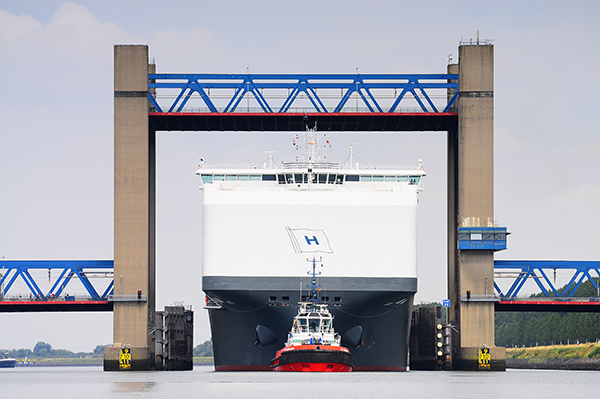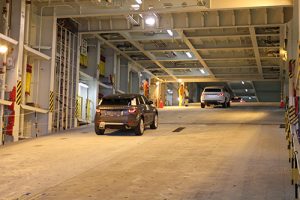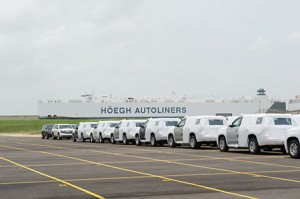 Christopher Ludwig talks to Höegh Autoliners CEO Ingar Skiaker about the carrier’s change of strategy to focus on expanding its logistics, terminal services and short-sea shipping.
Christopher Ludwig talks to Höegh Autoliners CEO Ingar Skiaker about the carrier’s change of strategy to focus on expanding its logistics, terminal services and short-sea shipping.
Among veteran ro-ro executives there is currently a touch of nostalgia for the business of the 1990s and most of the 2000s. Trade patterns were stable and predictable out of Japan and Germany, with backhauls adding extra padding to already thick margins. Compared to today’s fragmented and shifting flows, complex regulations and low freight rates, they remember an easier time.
“Although it didn’t feel like it then, looking back it was a relatively easy business,” says Ingar Skiaker, chief executive officer of Norway’s Höegh Autoliners, which has a fleet of 50 pure-car-and-truck carriers (PCTCs).
Since then, economic and geopolitical forces have disrupted Höegh and the wider car trade, including the prolonged downturn in Europe, declines in Japanese exports, and the rise and fall in markets like Russia, South America and the Middle East. Höegh was hit again when its largest customer, General Motors, pulled Chevrolet out of Europe a few years ago, ending most of the vehicle shipments it carried to the continent from South Korea. Russia’s market collapse and GM’s subsequent withdrawal from there only poured salt on the wound.
Skiaker, who took over as CEO in 2011 after serving as chief operating officer, isn’t letting nostalgia cloud his vision. He believes Höegh, along with most ro-ro lines, let itself “get a little fat” in the run-up to the 2008 crisis, including in fleet capacity, operations and in management. As the crisis deepened in 2009, Höegh had 12 ships in layup out of a fleet of 45, with several vessels on order and ten planned to be cut in half and extended. “In that situation, you quickly realise you have to do something,” he says.
A cost-reduction programme and reorganisation followed. Admin costs have been halved since 2009, and Höegh has grown its business without increasing headcount. It continues to watch the waistline of its fleet carefully: even as 2015/16 sees it taking ownership of six ‘Horizon’ vessels, each with capacity for 8,500 cars, overall fleet growth is limited as charters expire.
A dedicated team now tracks fuel usage for every single vessel, with monthly plans to improve the worst five performers, something Skiaker says has saved more fuel than even new vessel designs. He credits the company with “a relentless pursuit of operational excellence,” which is a matter of survival for outbound logistics.“With OEMs, we are dealing with the most professional purchasing organisations in the world,” he says. “Automotive is a mature industry that competes relentlessly on price and quality, managing limited growth. That has profound impacts on the supply chain, including us. I don’t think that will ever change.”
An historic change of courseHowever, cost cutting has not been the company’s sole path to recovery. It has seen good growth in some markets, particularly for developing countries where most of the industry is currently suffering. Several years ago, Höegh made a bold move by establishing its regional sales base for Africa and the Middle East in India, despite not having any business in the country. Today, it is the market leader for Indian exports, with recent wins from GM, Volkswagen, Ford, Hyundai and Indian OEMs.
Similarly, despite having a smaller fleet than its Japanese rivals or its Norwegian neighbours, Höegh’s coverage of Africa is among the most extensive for PCTCs. In China, it has won new export business – including Volvo Car shipments to the US – and kept stable volume even as the country’s exports have declined.Fleet investments are also leading to changes. The post-Panamax Horizon vessels are engineered with ramps and door openings twice the size of other vessels, giving them greater capacity for project and high-and-heavy cargo, a growing focus area for Höegh.
 “Making things like logistics and short sea key parts of our product offering is in response to the industry’s changing patterns… The fragmentation of OEM production and distribution patterns means we have to be ready to offer trade lanes almost everywhere”
“Making things like logistics and short sea key parts of our product offering is in response to the industry’s changing patterns… The fragmentation of OEM production and distribution patterns means we have to be ready to offer trade lanes almost everywhere”
- Ingar Skiaker, Höegh Autoliners
By far the biggest developments are in the US and North America. In November, the company officially launched Horizon Terminals, a multi-purpose ro-ro processing centre in Freeport, Texas as a new gateway for the US Gulf region. Meanwhile, growing production and exports from Mexico are putting more vehicles on Höegh vessels moving to the US and onward to the Middle East and elsewhere. Skiaker reveals that the company is currently developing a short-sea shipping solution with dedicated services within North America.
These activities in North America are part of a strategy shift for Höegh that may be its most significant since the company fully entered the ro-ro business in 1973. Unlike rivals with more diverse cargo and logistics services, Höegh has traditionally focused on deep-sea car shipping. But now it is expanding logistics, terminal services and short-sea shipping, and creating new organisations to support them. Horizon Terminals in Freeport, for example, is incorporated under a small but separate daughter company, Horizon Terminal Services, for which Höegh has global expansion ambitions. Likewise, as it increases project cargo capacity with Horizon vessels, Höegh is installing its first break-bulk and high-and-heavy division.

Short sea in Mexico would also join other operations and joint ventures that Höegh has introduced, including its Euro Marine Logistics (EML) joint venture with MOL in Europe, Sinor in East Asia (a joint venture with China’s Sinotrans) and a one-vessel operation in the Caribbean that Skiaker is targeting for expansion.
Such logistics and short-sea services are not entirely new; Höegh has owned a forwarding and logistics company in France, Autotrans, for 15 years, while EML consolidated Höegh’s existing European short-sea fleet with MOL in 2011. High-and-heavy has always figured in its cargo mix but Skiaker admits Höegh never dedicated the necessary resources for it. However, all that is part of the ‘easy’ days that are now long gone.
“Making things like logistics and short sea key parts of our product offering is in response to the industry’s changing patterns,” says Skiaker. “We are among the last to make this shift. But we know that our customers are very discerning, and that we needed a proposition that adds value, or else it would fail.”
Steady at the helmIngar Skiaker has been well placed to lead Höegh’s efficiency drive. He first joined the company in 1981 and has held “almost every job you can have here.” He has seen Höegh and the ro-ro industry from the inside and out, having left the company twice, and has worked in other sectors for a decade.
As COO and then CEO, since 2009 Skiaker has simplified management and regional sales organisations, and outsourced several smaller agencies. He froze hiring at the company’s Oslo headquarters, offering redundancy packages where jobs were no longer deemed relevant. Most recently, Höegh created a joint venture with shipping services provider Wallem to do technical services for its entire ro-ro fleet, shifting management from Norway to Singapore.
“With 50 vessels, we didn’t have the size to do this efficiently, whereas Wallem serves more than 300 vessels. Together we get a scale effect in purchasing,” he says.Along with restructuring, Höegh took some calculated risks. Making India the regional lead for Africa and the Middle East showed commitment and helped establish relationships with carmakers even as the local industry struggled. At the same time, Höegh scaled back rather than fight for business in the red. It stepped out of the Europe-to-China trade for passenger cars when rates fell sharply and would have required diverting capacity from more sustainable services.
Such a focused approach will remain essential, as Skiaker expects flat volumes in deep-sea shipping. Even stable volumes would disguise “turmoil below the surface”, he says, as trade flows constantly shift. To that end, holding down costs must be accompanied by more flexibility, including adding or changing lanes quickly.
India is another useful example. While shifts in production to Mexico and the US have reduced deep-sea exports from Japan, Höegh has seen a substantial increase in exports from India to Mexico, including for VW, Chevrolet and, most recently, Ford. Höegh has an East Asia-to-US service that goes via the Middle East, and it now picks up in India on the way to Asia and then North America, offloading in Mexico and picking up vehicles bound for the US and the Middle East.
“Although we carry fewer cars from [East] Asia to the US, we have replaced the volume from India by making two different ports of call,” he says.
Höegh also now has a service that picks up cargo in India and makes deliveries around Africa before going across the Atlantic to North America. “The transit time is the same for customers in Mexico but it allows us to serve Africa, to which India exports quite a few vehicles and commercial equipment,” he says.
Similarly, Höegh has extended services for Chinese exports, with direct services for most major continents, including popular destinations for Chinese OEMs in east, west and north Africa, and the west coast of South America.
“The fragmentation of OEM production and distribution patterns means we have to be ready to offer trade lanes almost everywhere,” Skiaker says.
However, a shipping line of Höegh’s size cannot cover everywhere alone, and so has extended tonnage-sharing agreements. It has a long-standing partnership with Nissan Motor Carrier, owned by Nissan and MOL, and has recently agreed charter arrangements with Hyundai Glovis, the shipping and logistics arm of the Hyundai Motor Group.
 Höegh’s new terminal in Freeport, Texas is initially serving GM exports, but Skiaker expects it to become a major import hub, with potential to also be a gateway from Mexico
Höegh’s new terminal in Freeport, Texas is initially serving GM exports, but Skiaker expects it to become a major import hub, with potential to also be a gateway from MexicoNorth American dreamsNorth America is the focus of Höegh’s most ambitious developments. The Freeport terminal, which started operations in June, now has processing centres for both passenger cars and high-and-heavy cargo. It currently handles exports from GM’s SUV plant in Arlington, Texas and from its plant in northern Mexico to the Middle East. Next year Höegh expects around 100,000 vehicles at Freeport, and has expansion space for up to 500,000 vehicles per year.
Ingar Skiaker believes Freeport will eventually be dominated by imports, especially as a means to reach Texas, Gulf and central states with lower inland costs compared to coastal ports. It could also serve as a close entry point for vehicles moved by sea out of Mexico. Freeport is part of a flurry of terminal activity in the Gulf, including a new WWL facility in Galveston, Texas and others on Florida’s west coast.
Höegh currently has five services a month that move vehicles between Mexico and the US as part of wider, global routes, but Skiaker doesn’t think a long-term short-sea service is viable only as a part of global trades; it needs more frequent and flexible sailings with vessels that can serve smaller ports.
“I also don’t think a standalone short-sea operation would work without a deep-sea parent or in association with a deep-sea carrier,” he says. In Europe, for example, Höegh offers tonnage under EML with the tail end of its deep-sea routes.
While it is too soon for Skiaker to describe what shape Höegh’s Mexican short-sea service or partnership will take, he states that “it is absolutely part of our plan”.
Today, carmakers use short-sea shipping mostly for overflow from the railways, which makes shipping volumes volatile. Mexico’s role as a global exporter may also emerge as new plants come online, including for Audi, BMW, Toyota, Mercedes-Benz and Infiniti. (Click here for more on Mexico short-sea shipping.)
“I think we will see a different product offering in three or four years when full capacity ramp-up is complete in Mexico, and OEMs start to extend beyond feeding vehicles into North America and the US,” he says.
Steady in choppy watersVehicle shipping lines are still sailing in risky waters. Rates remain low and trade volume is stagnant, with declines in many markets. Europe may be seeing some recovery, but there is “war on either side of the continent and recession in between”, Skiaker says. Meanwhile, a slowdown in China is not only bad for shipping lines serving the country, but it also affects commodity-driven markets, like Brazil and Australia. Africa and the Middle East are as volatile as ever.
And although cheap bunker fuel has helped bottom lines, it is a “blip” as far as Skiaker is concerned; he thinks costs will rise, whether from environmental taxes or market demands.
If the US is the lone bright spot, that too is risky. Shipping lines will end up with more empty backhauls out of North America. Plus, an American slowdown would have wide-ranging consequences. Mexico’s miracle is mainly an extension of US demand. Even Höegh’s thriving exports from India to Mexico are linked to US sales, as OEMs allocate Mexican capacity for more profitable US-bound vehicles, and use India, for which Mexico has a free trade agreement, to build smaller, cheaper cars for the Mexican market.
However, Skiaker prefers to think about what he can influence rather than what he can’t. The coming years will see continued attention to Höegh’s cost base and the diversification of its business in areas like logistics, port services and project cargo. His vision for the future is a global network of more fuel-efficient vessels, complemented by short-sea operations in every region, along with terminals and logistics providers with global scope.
“Those are clear priorities and we’re not keeping them secret,” he says. “This business is not won by grand strategies, but by execution and a competent organisation. We’ll find out if we’re competitive in OEM tenders – that will be the moment of truth.”



































